
Most students as well as many adults use backpacks on a daily basis. They are convenient for hauling books and other daily supplies back and forth to school, work and home. While backpacks get an A+ for convenience, there is an underlying risk of musculoskeletal injuries to the neck and back if they are not used properly.
When wearing a heavy backpack, individuals tend to shift their head, neck, and/or body forward to adjust the load. This can cause improper spinal alignment. As a result, the disks between each vertebrae are not able to effectively provide the shock absorption and protect the spine. Additionally, a heavy load requires muscles and soft tissue to work harder. Thus leading to fatigue, back strain, pain, and a higher risk of injury with bending, twisting, reaching, and lifting activities.
Tips for Safe Backpack Use:
Carefully Select a Backpack
Backpack fitting is important as backpacks come in different sizes so pick one that fits the person’s body size. Look for wide padded shoulder straps and chest and waist belts. In addition, backpacks that have more than 1 compartment are also recommended so that items can be distributed more evenly.
Restrict the Load
Backpacks should be no more than 10-15% of body weight. For example, if a child weighs 100 pounds, their backpack should never exceed 15 pounds and ideally would weigh less than 10 pounds. Avoid excessive weight by only packing items that are needed for the day. If a backpack is consistently heavier than 15% of body weight, consider using one on wheels or roller bag instead. However, be sure to check with the school to make sure roller bags are allowed, as some do not permit them due to tripping hazard in the hallway.
Utilize Different Compartments
Keep heavier items closer to the back center of the pack (against the back) while lighter items should be placed in the front of the pack. Distributes items into different compartments to even out the weight.
Use Both Shoulder Straps
Try to evenly distribute the weight. This prevents leaning to one side causing spinal curvature when only using 1 strap. Padded shoulder straps reduce pressure on the shoulders. Additionally, a padded back can increase comfort as well as provide protection from sharp object inside the pack.
Fasten Chest Straps and Waist Belts
If available, utilize the additional straps to help shift the backpack’s load to the torso and hips. This allows the body to use its bigger muscle groups to carry the load as well as distribute the weight more evenly.
Position the Backpack to Rest in the Curve of the Back
The backpack should not hang more than 4 inches below the waistline.
Use Proper Lifting Techniques
Instead of bending at the waist to pick up a backpack from the floor, bend your knees while keeping the back straight to lower your body toward the floor. Pull the backpack close to your body and then push up into a stand by straightening your knees.
Parents can assist by keeping an eye out for warning signs and advising based on the guidelines or making adjustments to their pack. Watch for warning signs that a backpack may be too heavy or ill fitting. These include difficulties putting on or taking off the backpack, pain, tingling, numbness, or changes in side to side posture when wearing the backpack, and red strap marks on the front of the shoulders after removing the pack. Additionally, if the child is leaning forward when wearing or complaining of back pain, see where changes can be made.
If you have concerns about backpack use, back pain or postural concerns, Enablr Therapy has a team of physical and occupational therapists that can help. Contact us today.


